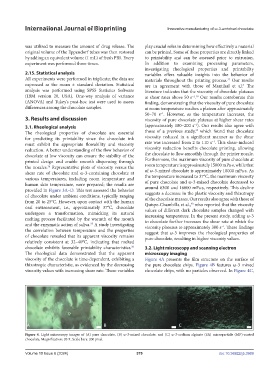Page 387 - IJB-10-6
P. 387
International Journal of Bioprinting Innovative manufacturing of ω-3-enriched chocolate
was utilized to measure the amount of drug release. The play crucial roles in determining how effectively a material
original volume of the Eppendorf tubes was then restored can be printed. Some of these properties are directly linked
by adding an equivalent volume (1 mL) of fresh PBS. Every to printability and can be assessed prior to extrusion.
experiment was performed three times. In addition to examining processing parameters,
investigating rheological properties and printability
2.15. Statistical analysis variables offers valuable insights into the behavior of
All experiments were performed in triplicate; the data are materials throughout the printing process. Our results
37
expressed as the mean ± standard deviation. Statistical are in agreement with those of Mantihal et al. The
6
analysis was performed using SPSS Statistics Software literature indicates that the viscosity of chocolate plateaus
(IBM version 20, USA). One-way analysis of variance at shear rates above 50 s . Our results corroborate this
−1 38
(ANOVA) and Tukey’s post-hoc test were used to assess finding, demonstrating that the viscosity of pure chocolate
differences among the chocolate samples. at room temperature reaches a plateau after approximately
50–70 s . However, as the temperature increases, the
−1
3. Results and discussion viscosity of pure chocolate plateaus at higher shear rates
−1
3.1. Rheological analysis (approximately 180–200 s ). Our results also agree with
39
The rheological properties of chocolate are essential those of a previous study, which found that chocolate
for predicting its printability since the chocolate ink viscosity reduced in a significant manner as the shear
−1
must exhibit the appropriate flowability and viscosity rate was increased from 2 to 110 s . This shear-induced
reduction. A better understanding of the flow behavior of viscosity reduction benefits chocolate printing, allowing
chocolate at low viscosity can ensure the stability of the the chocolate to flow smoothly through the printer nozzle.
printed design and enable smooth dispensing through Furthermore, the maximum viscosity of pure chocolate at
the nozzles. Representative plots of viscosity versus the room temperature is approximately 15000 mPa·s, while that
34
shear rate of chocolate and ω-3-containing chocolate at of ω-3-mixed chocolate is approximately 18000 mPa·s. As
various temperatures, including room temperature and the temperature increased to 37°C, the maximum viscosity
human skin temperature, were prepared; the results are of pure chocolate and ω-3-mixed chocolate decreased to
provided in Figure 3A–D. This test assessed the behavior around 6300 and 16000 mPa·s, respectively. This decline
suggests a decrease in the plastic viscosity and thixotropy
of chocolate under ambient conditions, typically ranging of the chocolate masses. Our results also agree with those of
from 20 to 25°C. However, upon contact with the human Quispe-Chambilla et al., who reported that the viscosity
40
oral environment, i.e., approximately 37°C, chocolate values of different dark chocolate samples changed with
undergoes a transformation, mimicking its natural increasing temperature. In the present study, adding ω-3
melting process facilitated by the warmth of the mouth to chocolate further increases the shear rate at which the
and the enzymatic action of saliva. A study investigating viscosity plateaus to approximately 300 s . These findings
35
−1
the correlation between temperature and the properties suggest that ω-3 improves the rheological properties of
of chocolate revealed that its apparent viscosity remains pure chocolate, resulting in higher viscosity values.
relatively consistent at 32–40°C, indicating that melted
chocolate exhibits favorable printability characteristics. 3.2. Light microscopy and scanning electron
36
The rheological data demonstrated that the apparent microscopy imaging
viscosity of the chocolate is time-dependent, exhibiting a Figure 4A presents the film structure on the surface of
thixotropic characteristic, as evidenced by the decreasing the pure chocolate chips. Figure 4B features ω-3 mixed
viscosity values with increasing shear rate. These variables chocolate chips, with no particles observed. In Figure 4C,
Figure 4. Light microscopy images of (A) pure chocolate, (B) ω-3-mixed chocolate, and (C) ω-3-sodium alginate (SA) microparticle (MP)-coated
chocolate. Magnification: 20 X. Scale bars: 200 pixel.
Volume 10 Issue 6 (2024) 379 doi: 10.36922/ijb.3969

